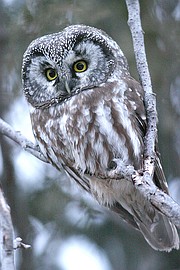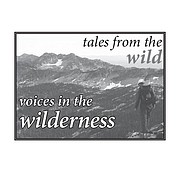Voices in the Wilderness: Forest Choir
After the snowfall, Old Man Winter rests. He is warm now, with his long white hair flowing down his shoulders. After conjuring up infinite patterns of snow flakes, each one unique, and gently laying down the soft blanket of albescence, he tucks his chin into his full beard and begins to dream. In the mountains, the creatures of the earth begin to stir after the quietness of the last flake falling has been fully appreciated.
The extreme northwest corner of Montana and the panhandle of Idaho present the rugged mountain ranges that include portions of the Whitefish, Purcell, Cabinet, Bitterroot, Salish and Selkirk mountains. The subalpine zone usually begins at 5,000 foot elevation. Here, the forest begins transitioning from lodgepole pine and mixed conifers. Depending on your location, elevation, and aspect, the forest changes to areas of mountain hemlock, subalpine fir, subalpine larch, Engelmann spruce and whitebark pine. Here trees begin to show the effects of their struggle for existence. Above this are the krummholz.
Stirring aftƒer the snowstorms in the subalpine forest are red-backed voles, and field mice who are hunted by the aggressive snow camouflaged long-tailed weasels, aka “ermine.” Also cloaked in winter concealment are white-tailed ptarmigan and the snowshoe hare. Ptarmigan and hares frequently fall victim to the silent, stealthy hunting techniques of the Canadian lynx, stalking on large, snowshoe-like paws and then quickly pouncing on their prey.
Another predator of the high country — an aerial attack master of hunting voles, birds and other small critters — is the boreal owl. Boreal owls range from approximately 3,800 feet to 7,000 feet. From a distance, their heads appear square, and there are no visible ear tufts. Eyes are yellow; the beak is yellowish white. The boreals silently glide down from relatively low perches to grab prey with their talons.
This small owl is about 10 inches high and weighs approximately five ounces. It is somewhat snow camouflaged. The facial disk is white, surrounded by a black ruff trim. The forehead is delicately spotted with white and the back of the head often has a few larger white spots or patches. The chest is white with brown vertical streaks down the chest, sides and flanks. The back is brown with somewhat larger white blotches.
This little owl is a high elevation, camouflaged killer. It often has what seems to be an angry expression. And perhaps it has a reason for this look. The boreals are kings and queens in their domains, and left alone.
Once thought to migrate, research has shown that they tend to remain in their home territory unless disturbed or the prey base gets scarce. This humble writer was fortunate to be part of research in the early 1990s. We were trained by experts to vocally imitate the series of eight to 20 low, whistled toots that get progressively louder and then drop off. We also utilize recorded calls to find and map out potential territories, mating areas and nesting sites.
For more than a month we worked extremely hard. Conditions were tough. Snowmobiles broke down and the work hours — 3 p.m. to 3 a.m. — were getting old. We snowshoed into the research area through three to four feet of snow, calling for the owls, often to no response.
Then, we found success. The night was clear with a plethora of stars, Venus showing brightly, and shooting stars to the maximum. It was also 20 below zero.
We decided to try one more set of male mating/territorial calls, and far off in the distance we heard a response! Then another, and another. Suddenly, there were groups of owls calling from every angle, almost surrounding us at about a half mile away. The ensemble of owls continued for an hour. The choral performance actually made us laugh with joy! After the crescendo and the return of silence, my buddy and I made our way back to the sleds and headed out, leaving the boreal owls with the spectacular view of a Montana night sky and their peaceful solitude.
Brian Baxter, principal of Silver Cloud Associates in Libby is an outdoor educator and wildlife researcher.
Voices in the Wilderness is a monthly column written by your neighbors and friends in and visitors to the vicinity of the proposed Scotchman Peaks Wilderness. Voices features memorable personal experiences in wild places. If you have an adventure tale based in untamed country (it doesn’t have to be local), write for guidelines, or just send it along to sandy@scotchmanpeaks.org





